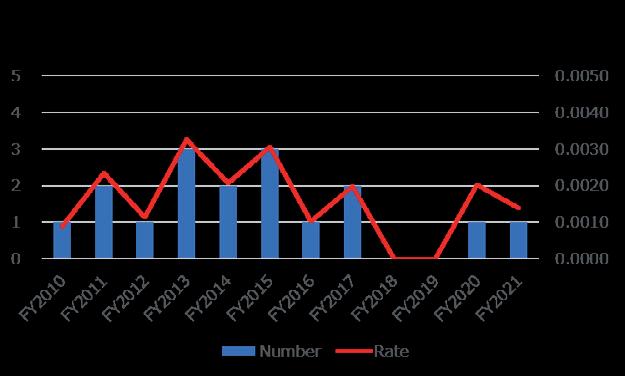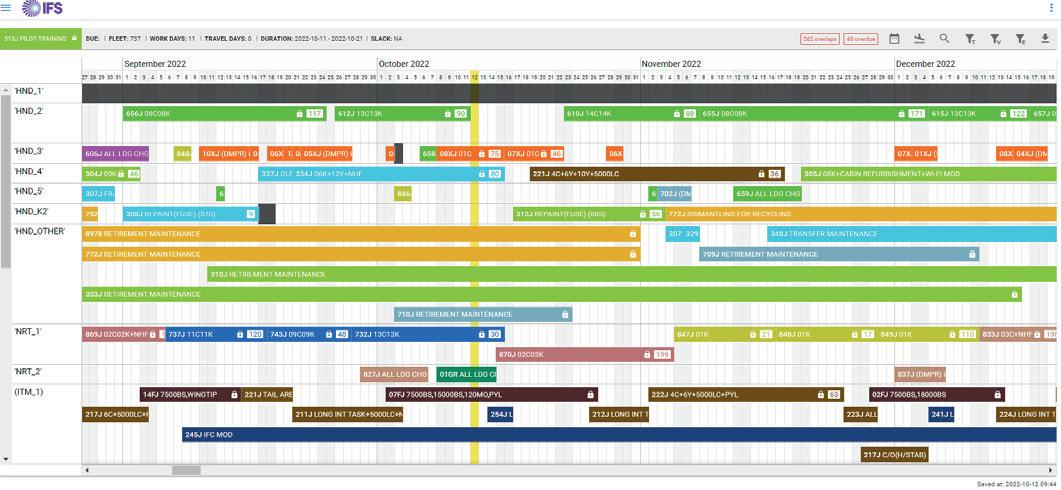
6 minute read
Volocopter takes off with AMOS
At the end of May 2023, Swiss Aviation Software (Swiss-AS) and Volocopter cosigned a landmark multi-year contract for AMOS, Swiss-AS’s maintenance, repair, and overhaul (MRO) software. AMOS will be used to manage Volocopter’s electric vertical takeoff and landing (eVTOL) aircraft fleet worldwide. Seamless software integration will ensure continued fleet airworthiness, offer aircraft reliability monitoring and analysis, and act as an interface to Volocopter’s proprietary digital operating system, the VoloIQ. This is the first time Swiss-AS is collaborating in an urban air mobility (UAM) setting, a key development as Volocopter prepares for entry into service in 2024.
As the UAM industry pioneer, Volocopter is set to receive type certification (TC) in 2024 for its VoloCity, a 2-seater electric air taxi built for city use. The company will be the first to launch commercial services in Europe that meet the same very high safety standards that commercial airliners must satisfy. Besides product certification, a successful industry launch and future operations scale-up require a solid UAM ecosystem. Plus, eVTOL fleets in global megacities will need to deliver fast turnaround times to maximize vertiport and airport space and provide an efficient customer service.
AMOS excels at managing vehicle configuration traceability throughout its life cycle, a critical aspect of proper aircraft fleet maintenance. Further such aspects include component design/ purchase dates, installation/replacement dates, and total operating hours. AMOS will also monitor ground handling operations, deploy the relevant tools, and manage ground staff assignments. Ground technicians will use AMOSmobile/EXEC, a touch-optimized mobile maintenance solution for ‘live’ data streams. Further, artificial intelligence (AI) will enable reliability monitoring to improve fleet management efficiency. Meanwhile, Volocopter’s VoloIQ backbone will monitor customer-facing services like the booking process, as well as aircraft location and status, and battery health. Interlinking Volocopter’s air- and ground-side operations will create a fast, transparent, and safe fleet management system to support eVTOL operations scaling.
“We are looking forward to stepping into the future of urban air mobility with Volocopter. Signing with Volocopter is confirmation that AMOS stands for innovation! All Swiss-AS employees received the news with excitement and we look forward to cooperating with the UAM pioneer Volocopter, who is designing the customer journey from A to Z while complying with the highest safety standards.” stated Fabiano Faccoli, Chief Executive Officer of Swiss Aviation Software.
“With Swiss-AS as a partner, Volocopter is making strides to ensure that the maintenance of our VoloCity is managed and executed efficiently and is foolproof. The AMOS software has a proven track record in the aviation industry — giving us confidence to obtain our Continuing Airworthiness Management Organization (CAMO) and Maintenance Organization Approval (MOA), which is essential for our entry into service. Its compatibility with our VoloIQ is a must-have to provide outstanding customer service.” added Oliver Reinhardt, Chief Risk & Certification Officer of Volocopter.
Seamless and efficient maintenance and ground-side operations ensure the safety of passengers, ground crew, and aircraft, simultaneously enabling the fast scaling of the UAM ecosystem. Volocopter is strengthening all areas of its ecosystem: product certification, production, air- and now maintenance and ground-side operations. This industry-first collaboration between Swiss-AS and Volocopter will build the foundation and deliver best practices that will permit ongoing improvements to future eVTOL operations.
Volocopter: Volocopter brings urban air mobility (UAM) to megacities worldwide. We aim to improve the quality of life for people in cities by offering a fantastic new mode of transportation. For that, we create sustainable and scalable UAM ecosystems with partners in infrastructure and operations. Volocopter’s family of eVTOL aircraft will offer passengers (VoloCity and VoloRegion) and goods (VoloDrone) swift, secure, and emission-free connections to their destinations, supported by VoloIQ, the UAM ecosystem’s software platform that serves as its digital backbone for safe and efficient operations.
As a pioneer in the UAM industry, Volocopter will launch commercial services within the next few years. Founded in 2011, the company employs more than 500 people in Germany and Singapore, has completed over 1,500 successful public and private test flights, and has diverse investors, including Geely, NEOM, Mercedes-Benz Group, Intel Capital, and BlackRock Read the full story on Aircraft IT Website


In this article, I’m going to share with you our experience using IFS Fleet Planner in JAL Engineering (JALEC). We’ll look at what it does and, importantly, at what benefits JAL Engineering has gained from using the new system. But let’s start by telling you something about JAL Engineering, the maintenance department of Japan Airlines (JAL).
JAL ENGINEERING CO., LTD. (JALEC)
Established in 2009, JALEC is 100 percent owned by Japan Airlines and has 4,000 engineers and mechanics with bases at Haneda (HND) and Narita (NRT) airports, Tokyo, as well as Itami (ITM) airport in Osaka. JALEC has certifications in 17 countries and regions and is responsible for the fleet management, engineering and quality management of 200 aircraft for four operators in the JAL group (JAL, J-AIR, ZIPAIR and Spring Japan) as their airline maintenance department. Also, JALEC is responsible, as an MRO, to provide services for the aircraft of more than 50 customers to-date — other airlines and the military in Japan. Those services include line maintenance, base maintenance, engine shop, component shop and training. JALEC’s annual revenue is about U.S. $1 billion.
Zero-Zero-Hyaku, 0-0-100
For Japan Airlines, Zero-Zero-Hyaku, 0-0-100, is a key objective today (figure 1). We shared the idea and what inspired it with readers in the March-April 2020 issue of AircraftIT MRO. Ultimate Goal ‘0-0-100’ word for us.
“JAL has approximately 200 aircraft which means that there are 400 engines to be operated every day. But, in 2018/19, JAL never had to shut down an engine in flight…” from the aircraft (PDAs). The second Zero means that there should be no defects in flight and the 100, in Japanese ‘Hyaku’, means that there should be 100 percent on-time departures by every aircraft. These are very stringent targets that JAL has set for its operations and which JALEC must support. Some might regard this as impossible, but we simply see it as a powerful challenge. It means that we never stop considering and acting towards the achievement of this goal. As part of that, we monitor our progress and Figure 2 shows our performance against that target and the ultimate goal of 0-0-100.
Figure 1
As the figure says, it’s a magic word for JAL but it’s difficult to understand. The numbers 0-0-100 have a meaning. The first Zero means that there should be no irregular operations, no inflight engine shut downs (IFSD) and no parts departing

In 2020 and 2021, COVID ensured that travel conditions were far from typical but it can be seen that, prior to the pandemic, there was a downward trend in irregular operations and engine inflight shutdowns. With regards to inflight shutdowns, JAL has approximately 200 aircraft which means that there are 400 engines to be operated every day. But, in 2018/19, JAL never had to shut down an engine in flight; they achieved that part of the Zero-Zero-Hyaku objective at that time. Also, for irregular operations, the rate is decreasing and approaching zero.


Ultimate Goal ʻ0-0-100ʼ
We should also consider the defect in flight rate (figure 3).
Ultimate Goal ‘0-0-100’
In 2019, JAL introduced the Airbus A350 EIS and, from then, the rate of defects in flight has been increasing. However, most of the fleet are not A350, as there are only about 16 of the aircraft in the fleet. Notwithstanding, the rate of defects in flight is steadily falling and approaching zero. Finally, parts departing from the aircraft (PDA) which is now decreasing every year, were increasing between 2017 and 2019, just prior to when the Tokyo Olympics were anticipated to have been held. The government was very focused on the PDA program because they opened a new route over Tokyo which generated an increase in PDAs but, since 2020, they have been decreasing.


How to achieve 0-0-100
This objective is a policy that shows us a direction but doesn’t offer a reason for the maintenance department. If you want to improve safety, you have to invest in aircraft, components and other materials which are very expensive which means, in turn, that you need to make a profit — a virtuous circle. However, if you cannot make a profit, you cannot invest and, therefore, cannot improve safety — a vicious circle. To achieve 0-0-100, we have to stabilize operations and improve efficiency; to do that, we have to increase revenue while reducing costs. That was JALEC’s motivation to introduce IFS Fleet Planner throughout our maintenance operation.

Ifs Fleet Planner
This is a Cloud-based software, a semi-automatic planning engine for the longterm base maintenance schedule. In figure 4 is a snapshot of IFS Fleet Planner.

What is IFS Fleet Planner (FP)?
-CLOUD based WEB APP software
-Semi-automatic planning engine for Long-term base maintenance schedul
Today
Month/Day the vertical axis, red edged box on the left, shows the hangars and bays, the places where we can undertake heavy maintenance. It shows that JAL Engineering has a hangar base in Haneda (HND) with six bays and two bays at Narita (NRT) There is also a bay at Osaka (ITM) and there are outsource maintenance facilities outside of Japan.
Overall, IFS Fleet Planner’s usability is very good and it is a simple step to introduce it into your process because it is a Cloud system. It’s also easy to use,










